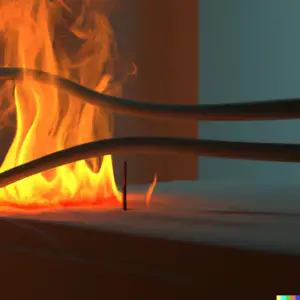If you have ever wondered why grounding electrical cables is important, you are not alone. Grounding is an essential aspect of any electrical installation, and it plays a crucial role in ensuring the safety and reliability of your electrical system.
In this article, we will discuss the importance of grounding electrical cables, the different types of grounding, and how to properly ground your electrical system.
Table of Contents
What is Grounding and Why is it Important?
Grounding is the process of connecting an electrical system to the ground through a conductor.
This conductor, known as the grounding conductor, is typically a copper wire that is connected to a grounding electrode, such as a ground rod or a grounding plate.
The purpose of grounding is to provide a safe path for electrical current to flow in the event of a fault or a surge.
Grounding is important for several reasons:
- Safety: Grounding ensures that any electrical faults or surges are directed away from people and property, reducing the risk of electrical shock, fires, and other hazards.
- Equipment Protection: Grounding helps to protect electrical equipment from damage caused by electrical surges or lightning strikes. Without proper grounding, electrical equipment can be severely damaged or even destroyed.
- Electrical Performance: Grounding helps to improve the performance and reliability of electrical systems by providing a stable reference point for voltage levels.
Grounding Shielded Power Cables: Best Practices and Recommendations
Grounding is an essential part of electrical installations and is necessary for safe and reliable operation of equipment. In the case of power cables, grounding the cable shield can help to reduce the risk of noise and interference in the signal. However, it is important to follow best practices and recommendations to ensure proper grounding and avoid ground loops that can cause issues.
In general, only shielded power cables should be grounded. These cables have a metallic shield around them that provides a low-impedance path for electrical noise and interference to flow to the ground. Grounding the shield can help to reduce the risk of noise and interference in the signal.
According to the National Electrical Code (NEC) Article 250.96, the cable shield should be grounded at one point only, unless specifically permitted or required otherwise.
This means that the shield should be grounded at either the source or load end of the cable, but not both.
Grounding the shield at both ends can create a ground loop that can induce noise and interference in the signal.
The Institute of Electrical and Electronics Engineers (IEEE) also recommends grounding the shield of power cables at one end only, unless otherwise specified by the manufacturer.
IEEE Standard 142-2014 “Recommended Practice for Grounding of Industrial and Commercial Power Systems” provides guidelines for grounding and bonding in electrical systems and recommends following the manufacturer’s specifications for cable grounding.
It is important to note that there may be specific cases where grounding the shield at both ends is required or permitted, such as for certain types of high-voltage cables.
In such cases, additional measures may be necessary to prevent ground loops and reduce noise and interference, such as using isolation transformers or differential amplifiers.
Ground only one end of the cable! Why?
IEEE and NEC, as well as other industry standards, recommend grounding the shield of a cable on one side only.
This is to ensure that the shield is at the same potential as the equipment it is connected to, while still allowing induced currents to flow through the shield and be safely dissipated.
If the shield is grounded on both sides, it can create a potential difference between the two ends of the cable, leading to induced currents that can interfere with the signal or power transmission.
This can result in noise, distortion, or other unwanted effects. Therefore, grounding the shield on one side only is a recommended practice to avoid these issues.
Never ground both sides!
Grounding the shield on both sides of a cable can potentially cause a temperature increase due to circulating currents flowing in the shield, which can cause the cable to fail.
The magnitude of the current will depend on the magnitude and frequency of the voltage difference between the two ends of the cable, as well as the impedance of the shield.
In some cases, this can cause the cable to overheat and fail, or result in other performance issues such as electromagnetic interference (EMI) or noise.
Conclusion
In summary, grounding the shield of shielded power cables is an important part of electrical installations, but it is important to follow best practices and recommendations to ensure proper grounding and avoid ground loops that can cause issues.
The NEC and IEEE recommend grounding the shield at one point only, unless otherwise specified by the manufacturer.
If in doubt, consulting a qualified electrician or engineer can help to ensure proper grounding and minimize the risk of noise and interference in the signal.

